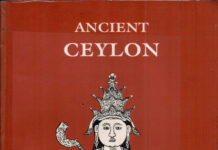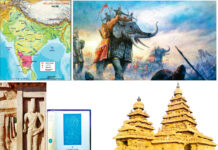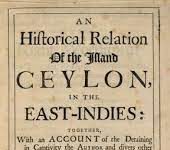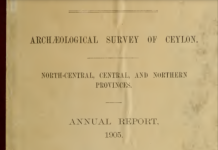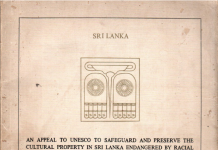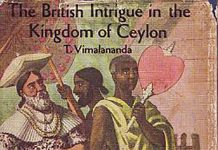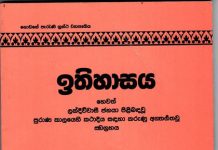Buddhaghosha Thera; a Dravidian origin?
During the time of King Mahanama (410 – 432 CE) the well-known Pali commentator, the Theravada Buddhist monk Ven. Buddhaghosha Thera arrived in Sri Lanka and visited Anuradhapura. He resided at the Mahavihara Monastery for years and composed commentaries in Pali following the then-existing Sinhala commentaries at the Mahavihara monastery. Although according to the Mahavamsa Ven. Buddhaghosha Thera was from the Bodh Gaya area in northern India, some scholars (such as Oskar von Hinuber and Ven. Polwatte Buddhadattha Thera) point out saying that he was born in Amaravati, Andra Pradesh. According to an article published in the Times of India on April 2016 titled, ‘Amaravati to Retain its Slice of History’, Ven. Buddhaghosha Thera was from Konta Nimalipuri, the Amaravati region. And the Sinhala Bhikku Aryadeva was a student of the famous Mahayana monk and guru Nagarjuna of Andra Pradesh. According to Rhyse Davids, Pali – English Dictionary (1921), the epilogues to Ven. Buddhaghosha Thera’s commentaries make reference to only one location in India for being a place of residence of Ven. Buddhaghosha Thera which is Kanchipuram in South India.
Son of a Dravida wife murdered by the daughter of the chief queen
After the death of King Mahanama, one of his sons, who was born to a Dravida wife, becomes the king. According to the Mahavamsa, his name is Soththisena. However, according to the Pujawaliya, Rajawaliya, and Rajarathnakaraya, his name is Sengoth. King Soththisena was murdered on the very day he became king, by his half-sister, Princess Sangha who was the daughter of the chief queen. Princess Sangha was married to Chaththagahaka and she placed him as the king. According to the Mahavamsa, he could only rule for one year as he dies after one year. After him, referred to in the chronicles as a powerful person, yet, whose identity is not clear, becomes the king and according to the Mahavamsa, his name is Miththasena.
Six Dravida kings seize Anuradhapura and rule for more than two decades
After one year of King Miththasena’s (432 – 433 CE) rule, another Dravida invasion occurs. A Dravida named Pandu kills King Miththasena and declares himself king.
Pandu (433 – 438 CE), Parinda (438 – 441 CE), Kuda Parinda (441 – 456 CE), Thirithara (456 CE), Datiya (456 – 459 CE), and Pitiya (459 CE) were six Dravidians who ruled Rajarata (the northern parts beyond the Mahaweli River) for more than two decades.
Many Sinhalese royals and elites who couldn’t bear the rising Dravidian power in the Rajarata area fled to the Ruhunu Rata. According to the chronicles, this was a doomed period in the Sinhala kingdom as the Sinhalese lost their authority over the monarchy.
As Prof. Senarath Paranavitana and C.W. Nicholas write in A Concise History of Ceylon during the time of King Kuda Parinda the Sinhalese fought back for their rights over the kingship of the island. He was the third Dravida ruler of this group. During the time of the next three Dravida kings, the uprising of the Sinhalese grew into a stronger organised battle, which eventually led to the victory of the Sinhalese after a struggle of a few years.
Were they Buddhists?
When studying the time of these six Dravidian rulers, we need to understand that they have patronaged Buddhist temples and we do not see any attempts of them to demolish Buddhist temples or records of execution of Sinhalese or Buddhists of the Rajarata area.
As the chronicles say Sinhalese royals and elites fled Rajarata and the reason we can assume as to why they did so could be that as they were the rightful owners of the throne, the Dravida kings saw them as a threat and attempts were made to execute those who belonged to the royal family and the elites who had the possibility to lead a battle against the Dravida kings. This assumption is correct as when we study the chronicle records about the story of King Dhathusena (459 – 477 CE), it says that the Dravida kings were searching for those possible Sinhalese princes who would claim their right over to the Sinhala monarchy. Thus, the royals and elites fled to the Ruhuna country and organised uprisings against the unlawful usurpers in Rajarata.
As mentioned in A Concise History of Ceylon two inscriptions of these Dravida rulers reveal details of them doing offerings to Buddhist temples. What is more interesting is that their names are mentioned in these two inscriptions. King Parinda is mentioned as Paridadeva and King Kuda Parinda as Budadasa La Parideva. A third inscription which is at the Kataragama Kiri Vehera premises belongs to King Datiya, son of King Thirithara. King Datiya has done offerings to the Kiri Vehera.
As Prof. Paranavitana and Nicholas explain, three of the six Dravida kings have served Buddhism and one of them has used the name ‘Budadasa’ which means, He who serves the Buddha. This could mean that they were Buddhists or maybe that they were serving Buddhism while they ruled the throne of a Buddhist kingdom. The other point to be noted is that while being rulers only in the Rajarata area, they have visited the Kataragama Kiri Vehera which belongs to the ancient Ruhunua Rata area.
Were they princes of a Pandya royal dynasty?
Further explaining these six Dravida kings, scholars Prof. Paranavitana and Nicholas say that they should be belonging to a Dravidian royal lineage or dynasty that had an army which was consisted of their own people.
According to some historians, their names suggest that they were of Pandya origin.
King Dhathusena ends the Dravida rule and unites the island
During this time of despair, we see the rise of the Maurya royal dynasty (Sinhalese) back to power and Prince Dhathusena rises as the brightest star of the Sinhalese Maurya royal dynasty. In this article, we do not intend to explore the tiresome and courageous journey of this valorous prince who later becomes one of Sri Lanka’s greatest kings under whose rule Sri Lanka saw a golden period of economic prosperity. However, we fear we might cause unjust to this great ruler who rescued to the kingdom from a time of despair and re-established the Sinhala monarchy, built great works of irrigation, reformed Buddhism, and brought the country’s economy and agriculture to great heights. We shall explore his life in one of our future segments.
Prince Moggallana and his life in India
After the rivalry occurred between the two brothers (half-brothers who were sons of King Dhathusena), Kasyapa (477 – 495 CE) and Moggallana, Moggallana fled to India. The chronicles do not say which part of India he was living in for 18 years.
After becoming the king, Moggallana (495 – 512 CE) strengthened the security of the coastal areas of the island. As scholars Prof. Paranavitana and Nicholas explain, King Moggallana’s this attempt can be seen as an attempt to strengthen the naval military powers of the kingdom and also as he was concerned about invasions from South Indian kingdoms to the island.
Moggallana II and the Kalinga king
During the time of King Moggallana II (535 – 555 CE) the king, queen, and a minister of the Kalinga kingdom fled to Sri Lanka as refugees. Kalinga was in a terrible war during this time. The Sinhala king has provided security and sanctuary to the three. Later, the three of them entered monkhood and the king built three temples for them to spend their lives.
King Silameghawanna defeats a Tamil army led by a Sinhalese leader
During the time of King Silameghawanna, also known as Asiggahaka, he had to face an invasion led by a Sinhala leader. A few years ago, during times of internal conflict between dynasties and members of the royal family, Prince Jettathissa’s uncle who was an army general had fled to South India. He was living there.
When Silameghawanna was king, he returned to the island with a Tamil army and fought to seize power in the Northern part of the island. The king succeeded in defeating them and he made the surviving Tamil soldiers slaves and distributed them to temples (this should not be misunderstood in reading them in modern terms. The chronicles use the word Tamils, Damilas, and Dravidas to mean invaders from any part of South India and even sometimes they use these words to refer to invaders not necessarily from India, but anyone who is foreign. Also, this does not directly and /or necessarily refer to the ethnic group that is today known as Tamils those who are living in Sri Lanka).
The king also sent some monks to India as a punishment. During his time he was informed about the wrongdoings and misbehaving of the monks of Abayagirya monastery. Therefore, he conducted an inquiry and punished the accused. About 100 monks who were accused of minor wrongdoings were banished to India as a punishment.
King Aggabodhi III flees to India
Prince Jettathissa who was in the hill country waged war against the king and the king was defeated. The defeated king fled to India.
We do not know exactly to which part of India he fled. After some years, King Aggabodhi (second time rule 633 – 643 CE) returned to the country with a Tamil army while King Jettathissa III was in power. He faced an unfortunate end during this battle and he ended his own life.
A growing population of Tamil soldiers in the Anuradhapura Kingdom
By this time, during internal conflicts Sinhalese princes and kings would flee to India for their safety, and princes and kings of various Indian royal dynasties would come to the Sinhala king expecting security and sanctuary when they were facing life threats during wars in their own kingdoms.
Also, by this time, it has become a practice that Sinhalese princes and kings would use large Tamil armies that they would bring from South India to seize power in Anuradhapura. As chronicles record, the victorious king would make these soldiers slaves and make them work for him or at temples. Thus, we could assume that if the king who had the support of the Tamil army won, these soldiers would have settled on the island, serving the king. In this way, the demography of the island gradually changed with a slowly growing Tamil population on the island.
To be continued…
(Information courtesy; The Mahavamsa, A Concise History of Ceylon by Prof. Senerath Paranavitana and C.W. Nicholas, Buddhist Remains of South India by Dr. D. Dayalan, and The Great Tamil Buddhists; The History of Buddhism in the Tamil Kingdoms of South India By T. N.Ramachandran)
By Ama H. Vanniarachchy

